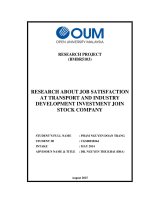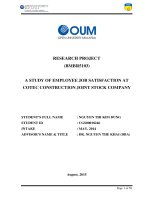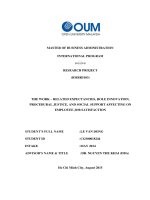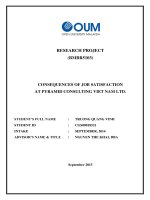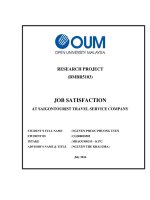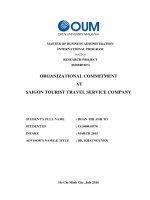Job satisfaction at saigontourist travel service company
Bạn đang xem bản rút gọn của tài liệu. Xem và tải ngay bản đầy đủ của tài liệu tại đây (1.58 MB, 91 trang )
RESEARCH PROJECT
(BMBR5103)
JOB SATISFACTION
AT SAIGONTOURIST TRAVEL SERVICE COMPANY
STUDENT’S FULL NAME
: NGUYEN PHUOC PHUONG UYEN
STUDENT ID
: CGS00018502
INTAKE
: MBAOUM0315 – K17C
ADVISOR’S NAME & TITLE
: NGUYEN THE KHAI (DBA)
July 2016
Advisor’s assessment
............................................................................................................................................
............................................................................................................................................
............................................................................................................................................
............................................................................................................................................
............................................................................................................................................
............................................................................................................................................
............................................................................................................................................
............................................................................................................................................
............................................................................................................................................
............................................................................................................................................
............................................................................................................................................
............................................................................................................................................
............................................................................................................................................
............................................................................................................................................
............................................................................................................................................
Advisor’s signature
MBAOUM0315 – K17C
Table of Contents
TABLE OF CONTENTS
ACKNOWLEDGEMENT
ABSTRACT
CHAPTER 1: INTRODUCTION............................................................................................ 1
1.1
Introduction of Saigontourist .......................................................................................... 1
1.2
Business Objective .......................................................................................................... 1
1.2.1
Core business ........................................................................................................... 1
1.2.2
Inbound Travel ........................................................................................................ 1
1.2.3
Mission statement .................................................................................................... 2
1.2.4
Vision ....................................................................................................................... 2
1.3
RESEARCH INTRODUCTION .................................................................................. 6
1.3.1
Research Problems Statement ............................................................................... 6
1.3.2
Research Objectives ............................................................................................... 7
1.3.3
Research Scope ....................................................................................................... 7
1.3.4
Significance of research ......................................................................................... 8
CHAPTER 2: LITERATURE REVIEW ............................................................................... 9
2.1
Definition of Construct .................................................................................................. 9
2.1.1
Global Job Satisfaction ........................................................................................... 9
2.1.2
Job control, Cognitive Demand and Production Responsibility .......................... 10
2.1.3
Supervisory Support .............................................................................................. 10
2.1.4
Developmental Experiences .................................................................................. 11
2.1.5
Role Justice ............................................................................................................ 12
2.1.6
Work Values Inventory .......................................................................................... 15
2.2
Research Model ............................................................................................................ 16
2.2.1
Research model ..................................................................................................... 16
2.2.2
Constructs ............................................................................................................. 17
2.2.3
Research Hypothesis ............................................................................................ 17
MBAOUM0315 – K17C
Table of Contents
CHAPTER 3: ARGUMENT FOR THE RELATIONSHIP AMONG THE
CONSTRUCTS ....................................................................................................................... 18
3.1
Maslow’s theory ........................................................................................................... 18
3.2
Herzberg’s Motivation Hygiene Theory .................................................................... 21
3.3
McGregor’s Participation Theory .............................................................................. 23
3.4
Urwick’s Theory Z ....................................................................................................... 26
3.5
Alderfer’s ERG theory ................................................................................................ 27
3.6
McClelland’s theory .................................................................................................... 31
3.7
Porter and Lawler’s Expectancy Theory................................................................... 34
3.8
Vroom’s Expectancy Theory of Motivation .............................................................. 36
CHAPTER 4: RESEARCH METHODOLOGY ................................................................. 39
4.1
Method of Data collection ........................................................................................... 39
4.2
Design template scale ................................................................................................... 39
4.2.1
Global Job Satisfaction ......................................................................................... 39
4.2.2
Job Control, Cognitive Demand, and Production Responsibility ........................ 41
4.2.3
Supervisory Support .............................................................................................. 42
4.2.4
Development Experiences ..................................................................................... 44
4.2.5
Role Justice ............................................................................................................ 45
4.2.6
Work Values Inventory .......................................................................................... 46
4.3
Data analysis ............................................................................................................. 46
CHAPTER 5: RESEARCH FINDINGS AND ANALYSIS ................................................ 48
5.1
Data Analysis ................................................................................................................ 48
5.2
Measure of each constructs ......................................................................................... 49
5.2.1
Global Job Satisfaction (GJS - main construct) ..................................................... 49
5.2.2
Job Control, Cognitive Demand, and Production Responsibility (JCP)................ 49
5.2.3
Supervisory Support (SS) ........................................................................................ 50
5.2.4
Developmental Experiences (DE) .......................................................................... 50
5.2.5
Role Justice (RJ) ..................................................................................................... 51
5.2.6
Work Values Inventory (WVI) ................................................................................ 51
5.3
Descriptive statistics .................................................................................................... 51
MBAOUM0315 – K17C
Table of Contents
5.4
Correlation statistics among the variables ................................................................ 53
5.5
Hypotheses testing........................................................................................................ 54
5.5.1
Hypothesis proposed (H1) .................................................................................... 55
5.5.2
Hypothesis proposed (H2) .................................................................................... 56
5.5.3
Hypothesis proposed (H3) .................................................................................... 57
5.5.4
Hypothesis proposed (H4) .................................................................................... 58
5.5.5
Hypothesis proposed (H5) .................................................................................... 59
CHAPTER 6: DISCUSSION AND RECOMMENDATION .............................................. 61
6.1
Discussion ..................................................................................................................... 61
6.2
Limitation of the research ........................................................................................... 61
6.3
Forecast recommendation ........................................................................................... 62
REFERENCE .......................................................................................................................... 64
APPENDIX 1: SURVEY ........................................................................................................ 69
APPENDIX 2: PRESENTATION ......................................................................................... 78
MBAOUM0315 – K17C
List of Tables
LIST OF TABLES
Table 1: Global Job Satisfaction Scale ..................................................................................... 40
Table 2: Job Control, Cognitive Demand, and Production Responsibility............................... 41
Table 3: Supervisory Support ................................................................................................... 43
Table 4: Developmental Experiences ....................................................................................... 44
Table 5: Role Justice ................................................................................................................. 45
Table 6: Work Values Inventory .............................................................................................. 46
Table 7: Cronbach‟s Alpha - Internal Consistency ................................................................... 48
Table 8: Cronbach‟s Alpha of Global Job Satisfaction ............................................................ 49
Table 9: Cronbach‟s Alpha of Job Control, Cognitive Demand, and Production Responsibility
.................................................................................................................................................. 49
Table 10: Cronbach‟s Alpha of Supervisory Support ............................................................... 50
Table 11: Cronbach‟s Alpha of Developmental Experiences ................................................... 50
Table 12: Cronbach‟s Alpha of Role Justice ............................................................................ 51
Table 13: Cronbach‟s Alpha of Work Values Inventory .......................................................... 51
Table 14: Descriptive statistics ................................................................................................. 52
Table 15: Correlation statistics ................................................................................................. 53
Table 16: Model summary of H1 .............................................................................................. 55
Table 17: Coefficients of H1 .................................................................................................... 55
Table 18: Model summary of H2 .............................................................................................. 56
Table 19: Coefficients of H2 .................................................................................................... 56
Table 20: Model summary of H3 .............................................................................................. 57
Table 21: Coefficients of H3 .................................................................................................... 57
Table 22: Model summary of H4 .............................................................................................. 58
Table 23: Coefficients of H4 .................................................................................................... 58
Table 24: Model summary of H5 .............................................................................................. 59
Table 25: Coefficients of H5 .................................................................................................... 59
MBAOUM0315 – K17C
List of Figures
LIST OF FIGURES
Figure 1: Research model ......................................................................................................... 16
Figure 2: Maslow's hierarchy of needs, represented as a pyramid with the more basic needs at
the bottom ................................................................................................................................. 19
Figure 3: Herzberg‟s motivational and hygiene factors............................................................ 22
Figure 4: McGregor‟s Participation Theory ............................................................................. 24
Figure 5: Alderfer‟s ERG theory .............................................................................................. 30
Figure 6: McClelland‟s theory .................................................................................................. 33
Figure 7: Porter and Lawler‟s expectancy model ..................................................................... 36
Figure 8: Vroom‟s Expectancy Theory of Motivation ............................................................. 38
MBAOUM0315 – K17C
Acknowledgement
ACKNOWLEDGEMENT
In order to completing thesis, the author always needs not only his efforts but also the
support of other people. Therefore, I would like to gives my best regards to those who
have been besides me and motivate me during the time of doing this research.
First of all, I would like to express my thankfulness as well as my attitude to my lecture
Nguyen The Khai (DBA) who give introduction carefully and basically. Without his
encouragement and comments, my thesis would not have been finished effectively.
Secondly, I would like to thanks to groups who assist in the process of data collection
and data entry for doing this research as an important part of this thesis. I also
acknowledge my thankfulness to those who give me valuable time, kind assistances in
participating in the survey.
Finally, my special thanks to all my family, my friends, my colleagues always
encouraged me and push me to complete this survey as well as give me more helpful
knowledge that is much useful in my work.
Nguyen Phuoc Phuong Uyen
MBAOUM0315 – K17C
Abstract
ABSTRACT
This research aimed to find which exact factors influence to the Global Job Satisfaction
of employees working at Saigontourist Travel Service Company Limited. This research
project is advised to use Business Research Methods to determine whether other main
factors affect to the Global Job Satisfaction or not.
The quantitative method was used to conduct this research with the source is surveys
by offline on 500 employees of Saigontourist to collect data. Moreover, the results of
statistics analyzed by SPSS version 20 software (Copyright of IBM) were proved by
Cronbach‟s alpha, Descriptive Statistics, Correlation and Multiple Regression
Analysis. The hypotheses used in this research were inclusive six constructs which are
one dependent construct (Global Job Satisfaction) and other five independent
constructs (Supervisory Support, Developmental Experiences, Role Justice and Work
Values Inventory).
Least but not last, the research outlined the relationship between dependent and
independent constructs are positive or negative. The research also pointed out some
helpful recommendation to managers of Saigontourist so that they can acknowledge the
problems are having in their company and then they will have effective solutions to
upgrade job satisfaction for employees in their company.
Key words in this research: Global Job Satisfaction, Supervisory Support,
Developmental Experiences, Role Justice and Work Values Inventory
MBAOUM0315 – K17C
Chapter 1: Introduction
CHAPTER 1: INTRODUCTION
1.1 Introduction of Saigontourist
Established since 1975, Saigontourist Travel Service Company, an affiliate of
Saigontourist Holding Company, has made its hallmark amongst the Vietnamese
leading travel management companies that have operated successfully in all three
primary tourism fields including inbound, outbound, and domestic travel.
Comprehensive development, continuing innovation and improvement in management
technology, serving style standardization and dedicated, professional, high-skilled staff
have paved the way for enhancing and strengthening Saigontourist‟s brand name
popularity.
1.2 Business Objective
1.2.1 Core business
Saigontourist Travel Service Co Ltd is specialized in designing and operating optimal
leisure tours, meeting & incentive travel & business travel services for customers with
consulting expertise, high-quality service, and product diversification.
1.2.2 Inbound Travel
Saigontourist Travel Service owns competitive advantages in the field of inbound
travel thanks to the partnership network covering many countries over the world. Since
established, Saigontourist has been trusted by international tourists for package tours of
diversified itineraries spreading throughout Vietnam.
Page 1 of 82
MBAOUM0315 – K17C
Chapter 1: Introduction
Outstanding products of Saigontourist are built based on Vietnam‟s great potentials of
tourism attractions, and Vietnamese strength and cultural depth, under many forms of
travel such as: sight-seeing, adventure, social–culture exploration, gastronomy, eco,
diving, golf, research, handicapped, and so on.
Cooperation network
Saigontourist Travel Service brand name has stretched far beyond the border as
broadening close partnership with over 400 travel companies, agents from many
countries and territories such as France, Japan, Germany, the United States of America,
Northern Europe, Spain, China, United of Kingdom, South of Korea, ASEAN, etc., and
official membership of international tourism associations (PATA, ASTA, USTOA,
JATA), Vietnam Tourism Association (VTA), Ho Chi Minh City Travel Association
(HTA).
Leading travel brand
Since 1999, Saigontourist Travel Service has been voted annually as the leading of Top
Ten Tour Operators by Vietnam Tourism Association and Vietnam National
Administration of Tourism.
1.2.3 Mission statement
“Saigontourist Travel Service, as a Viet Nam‟s leading tour operator, is committed to
creating the best values with its travel services for its customers, partners and to
guaranteeing the sustainable and harmonious development for the benefits of its staff
and social community”
1.2.4 Vision
Page 2 of 82
MBAOUM0315 – K17C
Chapter 1: Introduction
“Saigontourist Travel Service focuses on diverse business in terms of market, customer
and travel service & product in all fields of inbound, outbound and domestic travel
with an aim to become one of the leading travel companies in the region”.
Saigontourist – Business Philosophy
BUSINESS FOCUS – CUSTOMER FOCUS – STAFF & COMMUNITY FOCUS
Building, developing, and protecting Saigontourist‟s trade name over the past 36 years
is an interactive process under the collaboration between the company, customers, and
the community. The company‟s branding and business culture is comprised of
incessantly application of new management standards, development of customeroriented products and services, strong teamwork spirit, and full awareness of the
company‟s responsibilities towards the community…
On that fundamental, Saigontourist puts priority on:
Business Focus: Targeting sustainable business development.
Customer Focus: Satisfying all travel demands with best services. Increasing add-on
values throughout interesting personal experiences. Strengthening loyalty of current
customers and simultaneously attracting the potential ones.
Staff Focus: Human resources are determined to be an invaluable property of the
company. Treating every employee with appreciation is one of the core values in
Saigontourist‟s traditional culture.
Staff training is concentrated on a regular basis to enhance professionalism, dedicated
serving style, career knowledge and skills, teamwork spirit, as well as sense of
responsibility. The working condition has also received great care to improve solidarity
Page 3 of 82
MBAOUM0315 – K17C
Chapter 1: Introduction
and friendliness, becoming the second home to every employee so as to foster the
unanimity in developing Saigontourist brand name, paving the way for individual
income increase.
Community Focus: In addition to financial profits, Saigontourist has always aimed at
harmonizing the benefits of the social communities, while ensuring environmentalfriendliness as well as suitability with our socio-economic and cultural environment,
with a view to achieve an active and mutually supportive relationship with the
communities throughout diversified and practical sponsorship and charity programs.
Saigontourist – Corporate brand
The corporate brand of Saigontourist Travel Service and the Logo are registered to and
protected by the Vietnam Industry Proprietary & Author Copyright Bureau.
The Saigontourist Travel Service logo with a traditional „Mai‟ flower (apricot) is also
considered as a symbol of spring in Vietnam, and the yellow color of the flower
represents happiness, wealth, and prosperity. The letter S on the cyan background
illustrates the shape of Vietnam as well as the first letter of Saigontourist. The circle in
the center is designed with one vertical line and three cross lines to reflect the
continuingly extending partnership and business world scale. The logo incorporates our
company‟s full name “Saigontourist Travel Service” that is positioned within a unified
block, reflecting a sustainable development on a solid foundation.
What makes Saigontourist Travel different from competitors?
Saigontourist Travel Service is the only company in Viet Nam operating successfully
in all three primary tourism fields including inbound, outbound, and domestic travel.
As for inbound, Saigontourist Travel Service serving not only foreign tourists by air
but also by road, by sea and by river, and for leisure, business, MICE tourists. Our
Page 4 of 82
MBAOUM0315 – K17C
Chapter 1: Introduction
products have been developed by categories as Premium Travel, Traditional Travel and
IKO Travel. The distribution channel has been established include both online and
offline. We are now managing different websites such as:
-
(English);
-
(German)
-
(Japan)
-
(Russia)
-
(Spanish)
And seasonal websites for Vietnamese and Vietnamese oversea:
-
www.dulichhe.com (summer);
-
www.dulichthu-dong.com (Autumn – Winter);
-
www.dulichtet.com (tet festival);
-
www.dulichtietkiem.com (IKO Travel).
Our business strategy has made contribution to promoting Vietnam and Sagiontourist
in the source markets. Out effective marketing & promoting activities have
considerably contributed to our achievements. For years Saigontourist Travel Service
have been consistent in strategic approach to increase demand in the source markets.
Saigontourist Travel Service has promoted a positive image of Vietnam and Indochina
in the source markets.
Vietnam, Cambodia and Laos, “three countries, one destination” Saigontourist Travel
Service has promoted not only Vietnam but also Cambodia and Laos in our source
markets. Combination tour programs of Cambodia-VN-Laos, Cambodia-VN and LaosVietnam are always presented in our brochures, Saigontourist Travel Service web
pages, etc… as in our tour offers to tour operators in the source markets.
Page 5 of 82
MBAOUM0315 – K17C
Chapter 1: Introduction
1.3 RESEARCH INTRODUCTION
1.3.1 Research Problems Statement
The company is currently actively developing human resources; they especially focus
on the selection and retaining talented staffs to the company. Saigontourist is a big
company, so human resources management should have strict management system
effectively, especially keeping the loyalty of talented people stay with the company.
Recruiting the right people talent was hard, but to retain talent is even more difficult,
especially how to keep key persons is the most important task of the recruitment
department in the company.
Saigontourist is known for many talent staffs stay with the company very long, up to
thirty years. However, this amount is recently dropped significantly. This makes a huge
trouble to the Human Resources Department. That is why we have to conduct this
survey for the Job Satisfaction of staffs in the company and from then, we can
understand clearly about their needs about work condition nowadays.
With the shortage of qualified staff, to retain good people are becoming major issues of
Saigontourist. It is recognized that the Job Satisfaction of employees based on many
factors but I would choose five factors such as Job Control, Cognitive Demand and
Production Responsibility, Supervisory Support, Developmental Experiences, Role
Justice and Work Values Inventory, and I would like to research all these factors
whether they affect positively or negatively to the loyalty of employees. From then, I
would like to give some recommendation so that the company will have sustainable
plan for development of its human resources as well as help organizations operate more
efficiently, produce quality services, get the brand building, have customer confidence
and loyalty.
Page 6 of 82
MBAOUM0315 – K17C
Chapter 1: Introduction
1.3.2 Research Objectives
The purpose of this research is to find the factors influence to the Job Satisfaction of
employees working at Saigontourist. The research has three main steps:
-
Step 1: Define the meaning of Global Job Satisfaction and other related factors
affected on it.
-
Step 2: Give research model – Using quantitative methods by using index like
Cronbach’s alpha, Descriptive Statistics, Correlation and Multiple
Regression Analysis to analyze which factors really affect the Global Job
Satisfaction.
-
Step 3: Discussing and providing recommendation to improve the human
resources management at Saigontourist in the future.
1.3.3 Research Scope
The scope of this research is for all employees like Vietnamese or even foreigners,
from junior staffs to senior managers such as employees, subordinate, managers, Vice
General Directors and General Director working at Saigontourist. It does not including
Chairman, Board of Directors, Shareholders, supervisor Board and employees under
probation period or in maturity leave.
The survey scope is including 500 employees at Saigontourist. Contents of this
research focused on the degree of influence of factors affecting the Job Satisfaction at
Saigontourist. This survey purpose was not applied for restructure the operating
apparatus of the company, changing or replacing the employees‟ position.
This survey was conducted around one month from June 15 to July 15, 2016.
Page 7 of 82
MBAOUM0315 – K17C
Chapter 1: Introduction
1.3.4 Significance of research
This research will be useful for senior managers like managers, directors and even
CEO to understand whether their current staffs satisfy job or happy with their company
or not. From then, managers will have more efficient strategy in their recruitment
procedure, training and improving the loyalty of staffs. When staffs are satisfy with
their job, they will devote themselves to work and this is the most important in
development of a company.
Page 8 of 82
MBAOUM0315 – K17C
Chapter 2: Literature review
CHAPTER 2: LITERATURE REVIEW
2.1 Definition of Construct
2.1.1 Global Job Satisfaction
This measure was originally developed by Quinn and Shepard (1974). Then, the
concept of job satisfaction has been widely defined by different researchers and
practitioners; however, definition from Locke was the most impressive. Locke, (1976)
specified that job satisfaction is a pleasurable or positive emotional state resulting from
the appraisal of one„s job experiences. Worthy of note in this definition by Locke is the
use of both cognition (appraisal) and affect (emotional state). Thus, Locke assumes that
job satisfaction results from the interplay of cognition and affect, or thoughts and
feelings.
After few years, Rice, et al (1991) defined job satisfaction as an overall feeling about
one job or career in terms of specific facets of job or careers (e.g. compensation,
autonomy, coworkers). It can be related to specific outcomes, for example,
productivity. After that, Spector (1997) refined the definition of job satisfaction to
constitute an attitudinal variable that measures how a person feels about his or her job,
including different facets of the job.
According to the research of Fields & Blum (1997); McFarlin & Rice (1992); Pond &
Geyer (1991), Global job satisfaction correlated positively with satisfaction with the
facets of the job itself, supervision, promotion, pay, interactions with a boss, customer
contact, job freedom, learning opportunities, amount of decision making, and
satisfaction with co-workers. It also correlated positively with affective commitment to
an occupation and the organization, job involvement, the importance of interaction
with a boss and the importance of customer contact (Birnbaum & Somers, 1993;
McFarlin & Rice, 1992; Mossholder Bennett & Martin, 1998; Pond & Geyer, 1991).
Page 9 of 82
MBAOUM0315 – K17C
Chapter 2: Literature review
This measure uses six items to measure an employee‟s general affective reaction to his
or her job without reference to any specific facets.
2.1.2 Job control, Cognitive Demand and Production Responsibility
This measure was developed by Jackson, Wall, Martin, and Davids (1993). It assesses
the extent of job control, cognitive demand, and production responsibility an employee
experiences in a job. The job control covers timing control which means a job gives the
freedom to an employee in order to not only to determine the scheduling of his or her
work behavior and method control but also carry out tasks. The cognitive demand
gives the concept about the job, which is involves active, cognitive processing to
prevent or detect error, requires an employee to perform passive monitoring tasks.
Production responsibility which means a job involves responsibility for avoiding lost
damage to expensive equipment.
The structure of the five dimensions of the measure was confirmed with both
exploratory and confirmatory factor analysis
2.1.3 Supervisory Support
This measure was developed by Greenhaus, Parasuraman, and Wormley (1990). It
shows how many perceptions of supervisory support the employee receive in their job.
In general, supervisory support may include career guidance, performance feedback,
challenging work assignments and work opportunities that promote employee
development and visibility. Supervisory support correlated positively with perceptions
of acceptance, job discretion, job performance in terms of both tasks and relationships,
employee promotability and career satisfaction.
Supervisor support is defined as the extent to which leaders value their
employees’ contributions and care about their well-being. A leader with high
supervisor support is one that makes employees feel heard, valued, and cared
Page 10 of 82
MBAOUM0315 – K17C
Chapter 2: Literature review
about. Although it sounds simple, providing this kind of support is one of the hardest
transitions to make when promoted from employee to supervisor. The move from
“process expert” to “motivational leader” is possibly one of the largest steps one can
take in his/her working life. So why is supervisor support so important for effective
leadership? Because it is one of the key behaviors that effective leaders develop as
soon as they move from individual contributor to manager. (In fact, it leads to positive
outcomes at all levels of leadership) In specific terms, organizational research has
identified a myriad of positive outcomes associated with high supervisor support,
including:
Increased job satisfaction
Stronger person-organization fit (degree to which personality/beliefs/values match
organizational culture)
Increased organizational citizenship behaviors (OCB)
Improved employee perceptions of organizational support
Improved relationships with employees
In-role and extra-role performance
Reduced job tension
Reduced work-family conflict
Reduced turnover (a secondary effect)
2.1.4 Developmental Experiences
This measure was developed by Wayne, Shore, and Liden (1997). It mentions the
formal and informal developmental experiences a job affords employees. The measure
focus on the formal and informal training and development of an employee from an
investment of a company.
Page 11 of 82
MBAOUM0315 – K17C
Chapter 2: Literature review
Leadership Experience Examples:
Serve as a mentor to other colleagues, supervisees, or staff members or help to
onboard new colleagues.
Lead a project team/manage a group where team members are experts in areas
that you are not.
Lead a project that requires innovation.
Lead a division- or campus-wide project or task force that will have campus
policy implications.
Assume a divisional liaison role with Central HR on processes for:
o Outreach and recruitment
o Managing people issues
Chair a selection committee to fill a position.
Speak at a meeting.
Present at a conference.
Run for a position in a professional association on or off campus.
Take on a leadership role in a social, community, or volunteer organization.
These are just some examples of developmental experiences that can help employees
develop their skills. The unique experiences that can help employees progress toward
their career development goals will be created by themselves, in conjunction with their
supervisor or manager. Learning how to communicate to their supervisor that eployees
are open to and desire development experiences is important to getting the opportunity
to develop their career skills.
Show openness by being receptive to new ideas and suggestions, by admitting to their
need for improvement, and by actively seeking their direct supervisor/manager's
feedback. Keep in mind that the end goal is their career development, not the coaching
process itself. Even if it's difficult to hear constructive criticism in the short run, if it
helps to create development experiences for them it will help their career development
as a whole.
2.1.5 Role Justice
This measure was developed by Zohar (1995). It describes employee perceptions of
role justice as an employee‟s appraisal of fairness when the employee and a role
Page 12 of 82
MBAOUM0315 – K17C
Chapter 2: Literature review
sender‟s expectations do not make sense because of limiting conditions associated with
a job. Perceptions of injustice or unfair reactions may create role stress. Moreover,
perceptions of justice may moderate the effects of role stress, or moderate the effects of
role conflict and overload. When an employee is unable to meet the role senders‟ role
demands, it may be reduce the effects of overload, or increase the salience and
discomfort employees feel.
The study of organizational justice perceptions has received great attention from the
researchers and scholars and it has become frequently researched topics in the field of
industrial-organizational psychology, human resource management and organization
behavior (Cropanzano & Greenberg, 1997). Over the last 30 years, organizational
justice has been researched extensively in social psychology, specifically in
organizational contexts by psychologists and management researchers, among others
interested in the construct (Blakely, Andrews & Moorman, 2005; Moorman, 1991;
Trevino & Weaver, 2001). Perceptions of organizational justice constitute an important
heuristic in organizational decision-making, as research relates it to job satisfaction,
turnover, leadership, organizational citizenship, organizational commitment, trust,
customer satisfaction, job performance, employee theft, role breadth, alienation, and
leader-member exchange (Cohen Charash & Spector, 2001). Kim (2009) found that
employees who perceived that they were treated fairly by their company tended to
develop and maintain communal relationships with the company. Also, when
employees felt that they were treated fairly by their company, they were likely to hold
more commitment, trust, satisfaction, and control mutuality than when they perceived
that they were treated unfairly.
The research on organization justice perceptions which focuses on the role of fairness
in the work place have shown that organizational justice perceptions strongly effect the
Page 13 of 82
MBAOUM0315 – K17C
Chapter 2: Literature review
attitude of the workers such as job satisfaction, turnover intentions and organization
commitment and also workplace behavior such as absenteeism and organizational
citizenship behavior (Colquitt, Conlon, Wesson, Porter, & Ng, 2001). In addition,
research has also demonstrated the linkages between perceived organizational justice
and individual work performance (Colquitt et al., 2001, Earley & Lind, 1987).
Perceived organizational justice is found to be an important antecedent of
organizational citizenship behavior (Bakhshi & Kumar, 2009). Although the
associations between justice perceptions and various work outcomes are well
established in western literature a very few studies has examined the relationship of
justice perceptions with work attitude and work behavior in Indian culture. A number
of studies showed that culture do influence the justice perceptions of the employees
and culture is an important determinant of what impact does the justice perception will
have on various work outcomes. Tyler and his colleagues (Lind & Tyler, 1988; Tyler,
Boeckmann, Smith, & Huo, 1997) proposed that procedural justice concerns are
ubiquitous across diverse societal and cultural settings. Cross-cultural research on
procedural justice has recently begun (Brockner, Chen, Mannix, Leung, & Skarlicki
2000; Lind & Earley, 1992; Lind, Tyler, & Huo, 1997). A first question addressed by
cross-cultural procedural justice researchers is whether non-Westerners (i.e.,
collectivists) care about procedural justice issues as well (e.g., LaTour, Houlden,
Walker, & Thibaut, 1976). Similarly, Sugawara and Huo (1994) found that the
Japanese show a strong concern about procedural justice in conflict resolutions. White,
Tansky, and Baik (1995) reported that Korean subjects reveal concerns about
procedural justice, although their concerns are lower than those of American subjects.
The present study aims to find the relationship between justice perceptions, job
satisfaction an organization commitment and attempt to fill that research gap. We
provide a brief review of the conceptualization of the organizational justice construct
before reviewing the specific research questions explored in this article.
Page 14 of 82
MBAOUM0315 – K17C
Chapter 2: Literature review
2.1.6 Work Values Inventory
The Work Values Inventory (WVI), developed by Manhardt (1972), focused on job
characteristics. Although there is little evidence as to how the characteristics were
selected, the original study consisted of 25 job characteristics. After analysis of the
items, three factors emerged. Meyer, Irving, and Allen (1998) later confirmed and
labeled the three factors: Comfort and Security, Competence and Growth, and Status
and Independence. According to Leuty and Hansen (2011), comfort and security are
characterized by “a comfortable working environment including having a routine
schedule, leisure time, and good relationships with coworkers” (p. 380). The second
factor, competence and growth, is characterized by “the importance of responsibility,
advancement, and supervision of others” (p. 380). The third and final factor, status and
independence, is characterized by “independence, continued development of skills, and
intellectual stimulation” (p. 380). Manhardt‟s Work Values Inventory is of importance
as it asks a range of questions, at the item level, that are not included in other work
values measures. For example, the MWVI asked respondents if they valued
employment that 20 “permitted” a regular routine in time and place of work” (p. 380)
concerning comfort and security.
It assesses the importance of 25 difference job characteristics. Manhardt found 21 of
these characteristics group. These dimensions are includes three items which are
comfortable and security, competence and growth, and status and independence. The
1st item which is comfortable and security, includes job characteristics such as having
comfortable working conditions, job security and a regular routine. The 2nd item which
is competence and growth includes job characteristics such as intellectual stimulation,
continued development of skills, and a feeling of accomplishment. The last item which
is status and independence includes job characteristics such as opportunities to earn a
Page 15 of 82
MBAOUM0315 – K17C
Chapter 2: Literature review
high income, supervision of other employees, and working on problems of importance
to the organization (Manhardt, 1972).
2.2 Research Model
2.2.1
Research model
Figure 1: Research model
Dependent Variable
Global Job Satisfaction
Independent Variable
- Job Control, Cognitive Demand, and Production Responsibility
-
Supervisory Support
-
Development Experiences
-
Role Justice
-
Work Value Inventory
Page 16 of 82

